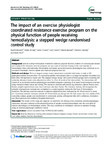The impact of an exercise physiologist coordinated resistance exercise program on the physical function of people receiving hemodialysis: a stepped wedge randomised control study
| dc.contributor.author | Benett, PN | |
| dc.contributor.author | Daly, RM | |
| dc.contributor.author | Haines, T | |
| dc.contributor.author | Barnard, R | |
| dc.contributor.author | Ockerby, C | |
| dc.contributor.author | Kent, B | |
| dc.date.accessioned | 2016-12-16T18:22:38Z | |
| dc.date.available | 2016-12-16T18:22:38Z | |
| dc.date.issued | 2013-09-01 | |
| dc.identifier.issn | 1471-2369 | |
| dc.identifier.issn | 1471-2369 | |
| dc.identifier.other | 204 | |
| dc.identifier.uri | http://hdl.handle.net/10026.1/8134 | |
| dc.description.abstract |
Background: Exercise during hemodialysis treatments improves physical function, markers of cardiovascular disease and quality of life. However, exercise programs are not a part of standard therapy in the vast majority of hemodialysis clinics internationally. Hemodialysis unit-based accredited exercise physiologists may contribute to an increased intradialytic exercise uptake and improved physical function. Methods and design: This is a stepped wedge cluster randomised controlled trial design. A total of 180 participants will be recruited from 15 community satellite hemodialysis clinics in a large metropolitan Australian city. Each clinic will represent a cluster unit. The stepped wedge design will consist of three groups each containing five randomly allocated cluster units, allocated to either 12, 24 or 36 weeks of the intervention. The intervention will consist of an accredited exercise physiologist-coordinated program consisting of six lower body resistance exercises using resistance elastic bands and tubing. The resistance exercises will include leg abduction, plantar flexion, dorsi flexion, straight-leg/bent-knee raise, knee extension and knee flexion. The resistance training will incorporate the principle of progressive overload and completed in a seated position during the first hour of hemodialysis treatment. The primary outcome measure is objective physical function measured by the 30-second sit to stand test. Secondary outcome measures include the 8-foot timed-up-and-go test, the four square step test, quality of life, cost-utility analysis, uptake and involvement in community activity, self-reported falls, fall’s confidence, medication use, blood pressure and morbidity (hospital admissions). Discussion: The results of this study are expected to determine the efficacy of an accredited exercise physiologist supervised resistance training on the physical function of people receiving hemodialysis and the cost-utility of exercise physiologists in hemodialysis centres. This may contribute to intradialytic exercise as standard therapy using an exercise physiologist workforce model. Trial registration: Current Controlled Trials ACTRN12612001223820. | |
| dc.format.extent | 204- | |
| dc.format.medium | Electronic | |
| dc.language | en | |
| dc.language.iso | en | |
| dc.publisher | Springer Science and Business Media LLC | |
| dc.subject | Exercise | |
| dc.subject | Resistance training | |
| dc.subject | Hemodialysis | |
| dc.subject | Dialysis | |
| dc.subject | Stepped wedge | |
| dc.subject | Cluster randomised control trial | |
| dc.subject | Cost utility analysis | |
| dc.subject | Exercise physiologist | |
| dc.title | The impact of an exercise physiologist coordinated resistance exercise program on the physical function of people receiving hemodialysis: a stepped wedge randomised control study | |
| dc.type | journal-article | |
| dc.type | Article | |
| plymouth.author-url | https://www.webofscience.com/api/gateway?GWVersion=2&SrcApp=PARTNER_APP&SrcAuth=LinksAMR&KeyUT=WOS:000325405500001&DestLinkType=FullRecord&DestApp=ALL_WOS&UsrCustomerID=11bb513d99f797142bcfeffcc58ea008 | |
| plymouth.issue | 14 | |
| plymouth.volume | 204 | |
| plymouth.publisher-url | http://www.biomedcentral.com/1471-2369/14/204 | |
| plymouth.publication-status | Published | |
| plymouth.journal | BMC Nephrology | |
| dc.identifier.doi | 10.1186/1471-2369-14-204 | |
| plymouth.organisational-group | /Plymouth | |
| plymouth.organisational-group | /Plymouth/Faculty of Health | |
| plymouth.organisational-group | /Plymouth/Faculty of Health/School of Nursing and Midwifery | |
| plymouth.organisational-group | /Plymouth/REF 2021 Researchers by UoA | |
| plymouth.organisational-group | /Plymouth/REF 2021 Researchers by UoA/UoA03 Allied Health Professions, Dentistry, Nursing and Pharmacy | |
| plymouth.organisational-group | /Plymouth/Research Groups | |
| plymouth.organisational-group | /Plymouth/Research Groups/Institute of Health and Community | |
| plymouth.organisational-group | /Plymouth/Research Groups/Plymouth Institute of Health and Care Research (PIHR) | |
| plymouth.organisational-group | /Plymouth/Users by role | |
| plymouth.organisational-group | /Plymouth/Users by role/Academics | |
| dc.publisher.place | England | |
| dcterms.dateAccepted | 2013-09-24 | |
| dc.identifier.eissn | 1471-2369 | |
| dc.rights.embargoperiod | No embargo | |
| rioxxterms.versionofrecord | 10.1186/1471-2369-14-204 | |
| rioxxterms.licenseref.uri | http://www.rioxx.net/licenses/all-rights-reserved | |
| rioxxterms.type | Journal Article/Review |


